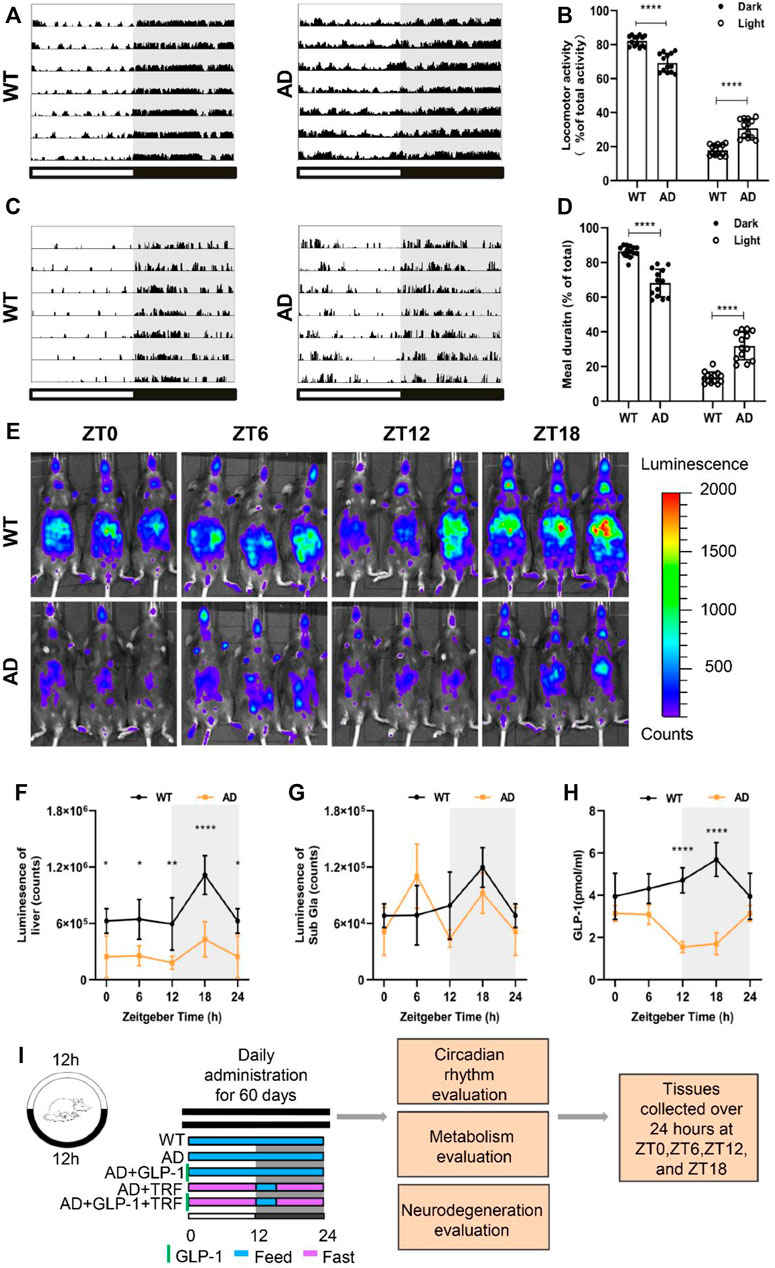Resetting the circadian clock of Alzheimer’s mice via GLP-1 injection combined with time-restricted feeding
- 1Department of Basic Medicine Sciences, School of Basic Medical Sciences, Dali University, Dali, Yunnan, China
- 2Department of Physiology, School of Basic Medical Sciences, Shenzhen University Health Sciences Center, Shenzhen, Guangdong, China
- 3BGI-Yunnan, BGI-Shenzhen, Kunming, Yunnan, China
A Corrigendum on
Resetting the circadian clock of Alzheimer ’s mice via GLP-1 injection combined with time-restricted feeding
by Dong Y, Cheng L and Zhao Y (2022) Front. Physiol. 13:911437. 10.3389/fphys.2022.911437
Error in Figure/Table
In the published article, there was an error in Figure 1B as published. Figure 1B is not fully displayed. The corrected Figure 1B and its caption Alzheimer’s disease mice exhibit circadian rhythm disturbances appear below.

FIGURE 1. Alzheimer’s disease mice exhibit circadian rhythm disturbances. (A) Representative locomotor activity records of 5 × FAD mice (AD) and wildtype mice (WT), respectively. Locomotor activity was defined as the moving distance per unit time (2 min). Each horizontal line represents 24 h. Periods of darkness are indicated by grey backgrounds. The black and white bars on the button indicate 12 h-dark and 12 h-light periods, respectively. (B) Percentage of the locomotor activity in the dark and light/total activity (24 h). n ⁼ 7 per group, ****p 0.0001, using two-way ANOVA followed by Sidak t test. (C) Representative meal duration records of two groups. (D) Percentage of the meal duration in the dark and light/total meal duration (24 h). n ⁼ 7 per group, ****p 0.0001, using Two-Way ANOVA followed by Sidak t test. (E) Representative photographs of PER2:LUC mice in vivo monitoring from each time point at 6 h intervals. (F,G) Raw photon count data of individual bioluminescence rhythms from E. n ⁼ 3 per group, n ⁼ 3 per group, *p 0.015, **p < 0.01 using Two-Way ANOVA test. (H) GLP-1 secretion levels in both groups. (I) The protocol design of our study.
The authors apologize for this error and state that this does not change the scientific conclusions of the article in any way. The original article has been updated.
Publisher’s note
All claims expressed in this article are solely those of the authors and do not necessarily represent those of their affiliated organizations, or those of the publisher, the editors and the reviewers. Any product that may be evaluated in this article, or claim that may be made by its manufacturer, is not guaranteed or endorsed by the publisher.
Keywords: amyloid-β, circadian rhythm, glucagon-like peptide-1, time-restricted feeding, Alzheimer’s disease
Citation: Dong Y, Cheng L and Zhao Y (2022) Corrigendum: Resetting the circadian clock of Alzheimer’s mice via GLP-1 injection combined with time-restricted feeding. Front. Physiol. 13:1077956. doi: 10.3389/fphys.2022.1077956
Received: 23 October 2022; Accepted: 04 November 2022;
Published: 21 November 2022.
Edited and reviewed by:
Rodolfo Costa, University of Padua, ItalyCopyright © 2022 Dong, Cheng and Zhao. This is an open-access article distributed under the terms of the Creative Commons Attribution License (CC BY). The use, distribution or reproduction in other forums is permitted, provided the original author(s) and the copyright owner(s) are credited and that the original publication in this journal is cited, in accordance with accepted academic practice. No use, distribution or reproduction is permitted which does not comply with these terms.
*Correspondence: Yingying Zhao, zhaoyingying@szu.edu.cn
†These authors have contributed equally to this work
 Yanqiong Dong
Yanqiong Dong Le Cheng
Le Cheng Yingying Zhao
Yingying Zhao